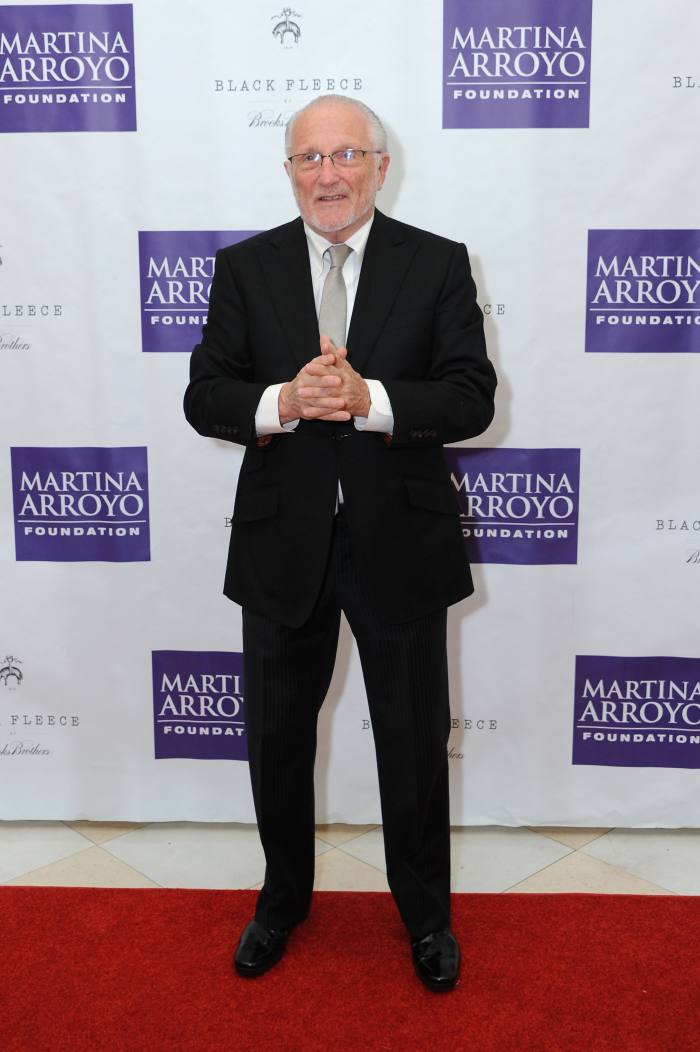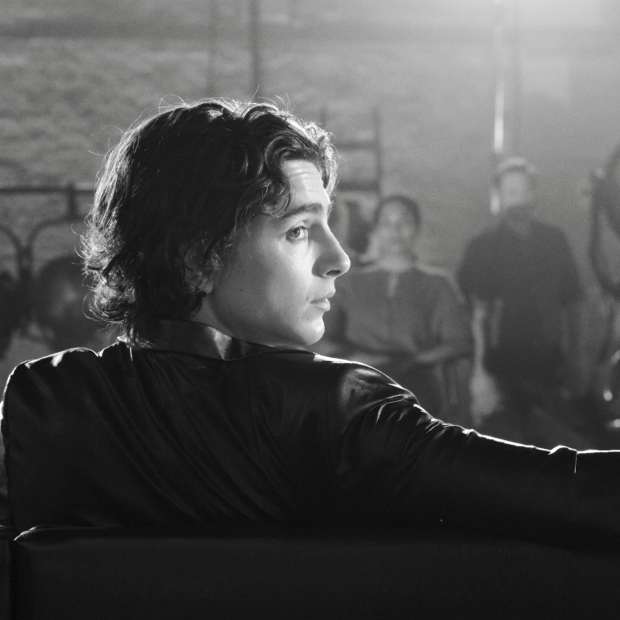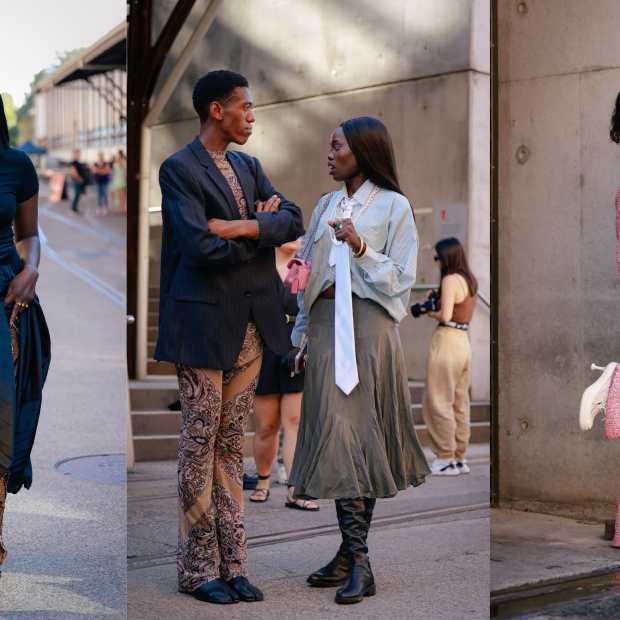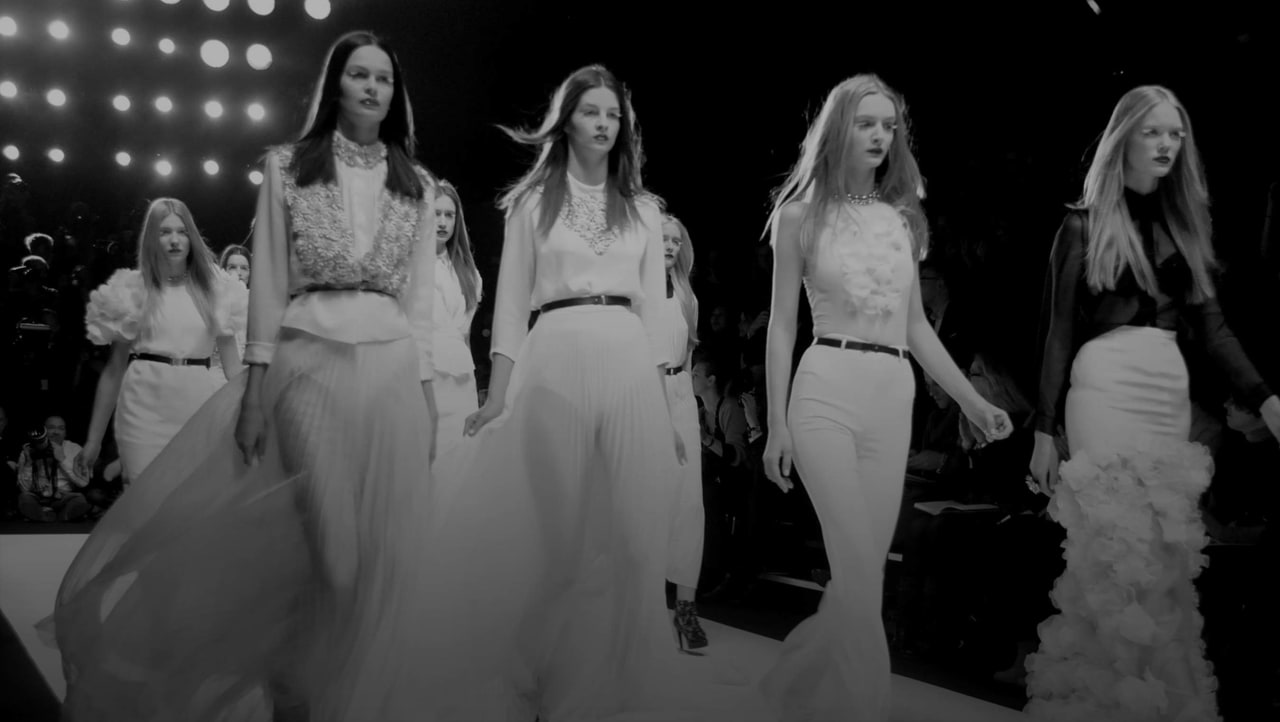How Stan Herman, Father of Fashion Week, Changed the U.S. Fashion Industry

Stan Herman and his former right-hand woman Fern Mallis at the 2015 CFDA Awards. Photo: Dimitrios Kambouris/Getty Images
From June 25 to July 4, we'll be examining — and at times, celebrating — all things American made, from the state of U.S. apparel manufacturing to American-born models on the rise. You can follow all of our coverage here.
"The thing that sums up Stan Herman, if you have to sum it up, is that I’ve been in just about everything," Herman says in his studio overlooking Bryant Park. "I’ve done bras, I’ve done security uniforms, I’ve designed evening clothes, I’ve done bridal gowns, I’ve just had a very long, long career being in the hot center maybe two or three times."
Indeed, Herman has had one of the longest and most diverse careers in fashion. After serving in the Army during the Korean War, he came to New York and started working as a designer in the Garment District. Fashion fame came early as a designer for the critically lauded Mr. Mort in the '60s. After the company closed in the '80s, Herman worked as a freelance designer and quietly built up a sizable business developing uniforms for major American companies like FedEx and McDonalds and charming audiences on QVC, where he still sells loungewear on live television today.
In the midst of all this, Herman served as president of the Council of Fashion Designers of America from 1991 to 2006, changing the industry forever by overseeing the first decade of New York Fashion Week in Bryant Park and shepherding its purchase by IMG in 2001.
I spoke with the designer at his studio about the early days of the CFDA, how he's managed to wrangle the industry's personalities over the years and the evolution of fashion week.
Tell me about your early days at the CFDA.
The council was a very small fraternity run by Eleanor Lambert, who was also a publicist. The industry was much smaller at that time but she was who really controlled the press in New York. She was smart enough to arrange press week. And she wanted to form a group of “better,” she called them, “couture American designers” who represent the art world in fashion, fashion as art and that really was the beginning of the first time that I can remember that any designer joined anything, because designers never joined anything. Especially when you go back before me, when you go back to the ‘40s and early ‘50s. Designers were just not political people at all.
Eleanor understood early on that there was a designer behind these things and she began to elevate them by representing them and then she formed the CFDA. The original list of CFDA members I think were 13 or 14. They were all designing what we call “better” clothes at that point. I remember I was a hot designer in the ‘60s, a really hot designer, and I found it hard to get into the CFDA. It took me until 1967 to get into the organization and I was just a member. There were maybe 40 of us.
I was always interested in the business of fashion, not how to run a business, but why it all existed. I was not married to draping or sketching or living the life of the creative person alone and very often fashion success comes very quickly if you don’t know where it comes from. All of sudden by a fluke I did a collection that seemed to work [for Mr. Mort] and I became a person in the industry which is really what it’s all about. There’s a little corral that you open the door to get in to. It still exists today and it’s the same thing. It’s a little bigger. And all of a sudden the people in that corral are your friends and those are the people that you know and then you realize that the people that you know are really the people. They are the ones that are making all the big decisions. And there are all these people outside looking in, so I was lucky. I was very lucky.
Then Perry Ellis was the president of the group at the time and I can’t tell you why but he asked me to be on the board and of course I was very excited about it. I went on the board and sat on that board for 10, 15 years. I seldom spoke, the meetings were run by Eleanor and then of course by Oscar [de la Renta] and Bill [Blass]. I was there, I was dependable, I did work but I wasn’t a mover and shaker at all. It was so controlled by Oscar and by Bill and Mary McFadden that we didn’t do anything. I didn’t understand why I was there. I just never thought it would be what it ended up becoming.
The AIDS epidemic occurred and like all things of those sort, it pulled people together. At the time the president of the CFDA was a woman named Carolyne Roehm. And we did a big gala which was run by Vogue, Anna [Wintour], Donna Karan and Carolyne. Nobody understood how incredible it was going to be, it was just a runaway success. We earned a lot of money and put it into the bank. And then out of nowhere, Carolyne said she didn’t want to be president anymore, which was a shock. I did not think that I was the next person in line.
It changed the whole way my life was in fashion at that point. I was sort of biting off the edges, I wasn’t in the hot center any longer, I wasn’t competitive with these people. They trusted me because I wasn’t their competitor and I was smart enough to know how to get along with them. I remember our first meeting in this studio when I was president. It was a fabulous meeting where I didn’t have enough chairs and I remember I sat on one of the high chairs because I wanted to be higher than Oscar and all the other people. We had a big problem — we had all this money in the bank and nobody knew what to do with it but finally we were an organization. And then I hired Fern Mallis, who became my executive director and a very positive woman who with me really believed that we could do lots of things for the industry. And 16 years later I was still there; she wasn’t any longer.
How did you have time to design and lead the CFDA at the same time?
I was no longer in the hot center, I had my loungewear business, my uniform business and the studio was sort of far from the maddening crowd. Also, on a personal note, my partner at the time died just when I became president of the CFDA so I had time, and it was great timing because otherwise I think would have… I don’t know what I would have done. Nobody really wanted the job after I took it because they thought it was such a hard thing to do. There were a number of people who thought, especially one or two of the designers, who didn’t [like] the direction that I was taking the CFDA in, so I always had a number of people to stave off and by the end of 16 years I was a little tired of it. I think I would have stayed, I was sort of pushed out in a nice way, in an honest way and we had an election which was very highly profiled everywhere. We wanted a new person and in the beginning I did not think that Diane [von Furstenberg] would be the person. I thought she was resurrecting her own career, we had other people in mind but in order to be a president you have to be on the board. I’m so happy she became president, she’s been extraordinary. She’s taken it three levels higher and she’s a major player in almost everything she does and she’s taken it very seriously, which I wasn’t sure of in the beginning. Definitely she’s not everybody’s cup of tea but she’s amazing.
How would you describe the direction you were taking the CFDA?
We were representing what was happening in the business. It was no longer a little Garment Center over there, we became more and more positive and globally accepted. Fern was a marvelous bulldozer. When she got an idea, she would really go for it. Fern was my executive director, then Peter Arnold, then Steven Kolb. I worked with him for a year before Diane took over.
And in this industry, as you know, there is somebody named Anna Wintour who is behind the scenes in almost everything and certainly was with me and the CFDA. They became in tandem with the CFDA. Vogue, CFDA — you don’t think of Harper’s. The Fashion Fund started at the end of my term but Diane and certainly Anna have taken it to a superb level at this point. Now there isn’t anything you can do without knowing that the CFDA is behind it. When I left we had five people working in the office, I think there are like 30 people now. It’s a big-time organization with lots of money flowing through it, lots of philanthropy going on and building a stronger fashion business.
Do you think fashion week will every be centralized again?
Yes it will be eventually. I think it will go to the Hudson Yards, the tent that they are setting up there, the Culture Shed. I think a lot is going to have to do — this is Diane’s last year — with who the next president will be and how long Anna stays on as the mover and shaker. I think we went through the most exciting time period, it was young and it was fresh, it was like kids off the block. Now it’s big business. We were constantly being criticized as being too commercial but when you do those kinds of things, you have to have money.
Recommended Articles
Your first test run for fashion week was a show for the Democratic National Convention in 1992, right?
Fern’s memory of it is even better than mine. The first shows that we did that we got everybody to join, there were no tents. We weren’t in [Bryant] Park, we were all in little areas around here. The first two tents, I always call them Bar Mitzvah tents. But once we were able to get down through the lawn, it was amazing.
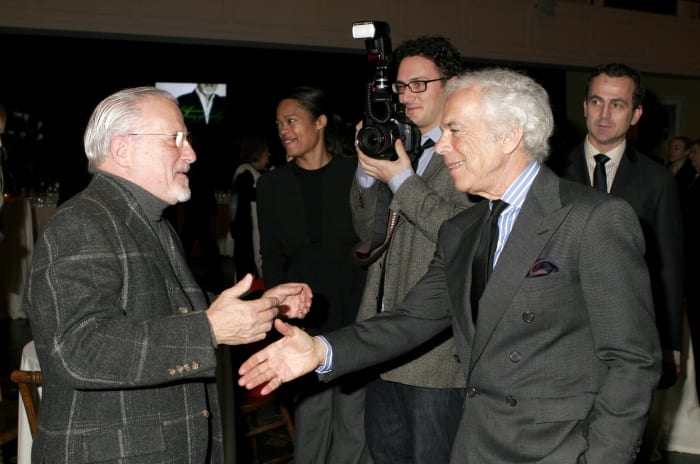
Stan Herman and Ralph Lauren at the FedEx and CFDA celebration of Herman's 16-year CFDA presidency in 2006. Photo: Donna Ward/Getty Images
How were you able to get all the designers on board?
Because I am who I am, I’m very open about what I want. I think they were happy to have me because they had no idea what was going on. All these people run big businesses. I was able to be where I had to be, I went to every committee meeting so that I had my hand in everything. But Diane doesn’t have to do that now. It’s just too big and Steven has enough people to work with him, but I had my enemies. I won’t tell you who they were but I had my enemies. And there were people who would have much preferred me leaving earlier than I did but I was able to hold on and then when I realized it was slipping away, I had to make that decision. It couldn’t be forever.
I always ended up doing what I wanted to do and Fern was my executive director for 10 years and was very, very hands on and in some cases a little controversial because she was so hands on. But it was fine for me, she protected me. She’s not the bad cop, she’s the front lady. She’s a personal friend of mine, a very close friend of mine, she lives right next door to me out in the country, we see each other all the time. She’s a force. I’m a different kind of force.
How about the sale to IMG? Was that a surprise or were you shopping it around?
It wasn’t a surprise, I was trying to sell it for a year. It was ruining the CFDA. We were running these fashion shows in tandem with the CFDA, we didn’t hire new people and the CFDA was beginning to suffer. Fern could just do so much and we were beginning to lose money. I’m the one who sold it so I sat down with them and eventually we made our agreement and it was the best thing I ever did. Of course, now it’s worth much more money than what I sold it for but it was money that we didn’t have.
And now New York Fashion Week is an international event.
The industry is just such a different industry. It’s so suggestive to the world. New York is where everybody wants to be for the moment, it may not last forever, it may go into the night. We were definitely not considered on the international level as the creators of fashion but that’s changed. I think the big thing that broke the barrier for us was when Oscar was hired to go to Balmain and that sort of thing. Then Marc [Jacobs] went over [to Louis Vuitton], then Michael [Kors] went over [to Céline]. That was unheard of when I first came into this industry. Nobody would ever do that but now people go back and forth and clothes look very much the same everywhere.
You dabbled in Broadway when you first moved to New York. How helpful is the performative side of your personality on QVC?
I love the camera. I just have to use a little more makeup now, that's all. It’s a tough business down there and I’ve been on it for a long time, so I’m one of the elder statesmen. They literally judge how much you sell by the minute. I’ve had phenomenal days and I’ve had awful days. It’s sometimes the merchandise, sometimes the timing, sometimes something happens in the world and people are not watching. It eventually evens itself out. I’ve been on for 22 years so I know that I can sell merchandise and if I stub my toe they know that's only a stub. Immediately the results hit, you’re not waiting for Bloomingdales to call you and say, "We didn’t sell it."
I’ve got some phenomenal numbers. When I was just selling bathrobes, I sold 100,000 bathrobes in a day. Which is a lot of bathrobes to sell. Everybody wants to be on QVC now. I can’t tell you how many people call me up and say, "Can you get me on QVC?" When I first when on QVC it was laughable. Designers would say, "How can you do that?"
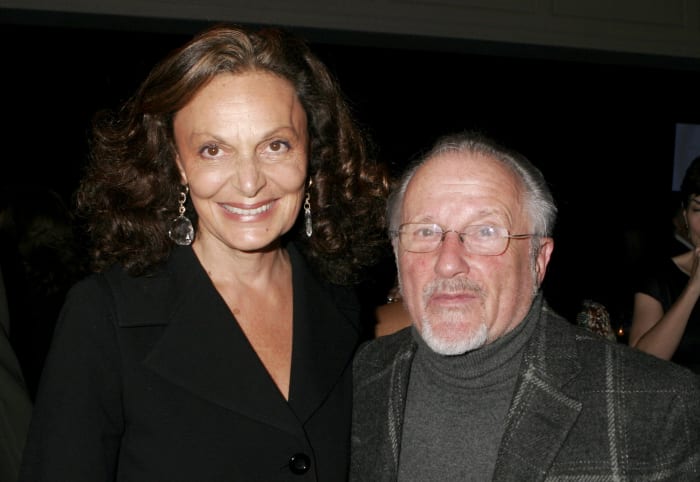
Diane Von Furstenberg and Stan Herman at the FedEx Corp and CFDA celebration of his 16-year CFDA presidency in 2006. Photo: Donna Ward/Getty Images
How do you approach uniform design?
I went into the uniform business in about 1975. It’s big business, billions and billions of dollars, everyone wears it. What I try to do is make uniforms look more like ready-to-wear and that’s what I did in the '70s and that’s what I still do and Michael [Schwarz] who works with me is the expert. We’re working on JetBlue now. As far as FedEx is considered, I’ve been doing that since 1980 and that’s amazing. So it’s quite a trip, you’d be shocked when you deal with uniforms you really deal with people that you get to know. I mean there was a time when I had MacDonalds, United Airlines, I think Acela. All these people! Everywhere I went there were Stan Herman uniforms. It was extraordinary.
Do you tell people you designed the uniform they're wearing?
Oh yes, I always do, they think I’m cruising them. I’m not kidding. I’m so proud of the new shirt we did for FedEx that I’ve been coming up to them and so far it’s been great approval. Sometimes it’s not; it’s the opposite. Like when I was doing a lot of fast food chains, we were moving into a lot of polyester. Not that I liked it, but that was what was going on. If I would have done it again, I would have never put those people in that kind of polyester but in a sense they were very iconic uniforms.
Is there anything you still want to accomplish?
I’m not looking forward to wasting time because there is so little time left. I’d like to be able to use it. I actually wrote a memoir which has been sitting on the shelf and has gone nowhere partially because I haven’t pushed it and partially because it's not complete but it’s mine, I wrote it, I didn’t have anybody else write it. That may be something that I’d like to finish before things are over. But I really should have a memoir out there. I’m one of the few people who really has been around and known people. I can remember when Seventh Avenue had a little drugstore on every corner and everybody had an egg cream for lunch. I can remember when the tailors came down from their lofts on Seventh Avenue for lunch every day to talk and decide who was going to hire which one — it was such a different time.
This interview has been edited and condensed.
